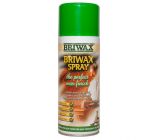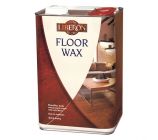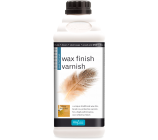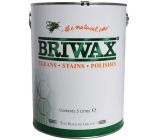
Wood Polish
-

Liberon Liming Wax
From:£10.95(inc VAT)multiple sizes -

Briwax Wax Spray aerosol (Clear)
From:£10.49(inc VAT) -

Liberon Floor Wax
From:£19.95(inc VAT)multiple sizes -

Rust-Oleum Furniture Finishing Wax
From:£13.49(inc VAT)multiple sizes -

Polyvine Wax Finish Varnish
From:£24.95(inc VAT)multiple sizes -

Briwax Original - Wax Polish
From:£15.95(inc VAT)multiple sizes -

Briwax Creamed Beeswax
From:£17.95(inc VAT)
What is wood wax?
Wood wax consists of paraffin, beeswax, and carnauba wax, blended together to create a sealant. Some more natural wood wax products combine only these elements, whilst other specially formulated mixtures also contain added colours and wood enhancers. Many wax polishes are available, with products to match the colour and appearance of each different type of wood.
Why wax wood?
Similar to varnishes and stain, the main effects of wax wood are to protect wooden surfaces from moisture and retain the colour of wood, so it is useful for keeping wooden furniture in good condition. It can also be used to restore antique wooden furniture as it enriches the patina without harming the wood. By comparison to other sealants, wood wax polish provides a much deeper shine and longer-lasting protection.
In addition to its protective properties, there are other reasons why wood wax is used around the home. Wood wax polish also acts as a light lubricant, meaning that it is perfect for wooden furniture with pull-out drawers. If the compartments on a chest of drawers are beginning to stick, applying wood wax all over the drawers can help them to open more smoothly as well as protecting the wood.
How to wax wood?
Before you can apply wood wax polish, you need to prepare the surface of the wood. This first step of the waxing process varies depending on the type of wood you’re working with and whether or not you’re attempting to restore an antique, so follow the instructions below carefully.
- Sand and prepare the wood
For wooden floors and non-antique furniture, you can simply sand the surface using a drum sander (and an edging sander for the edges). Make sure to use a dust mask and ear protectors for this part. Punch down any exposed floorboard nails so they don’t get caught, then sand the surface in line with the grain. Start with coarse paper like 24-grit paper, then work towards less coarse papers.
You need to be a lot more careful if you’re restoring antique furniture. Use less coarse papers from the outset and sand the surface of the wood by hand rather than using an electric sander. Bear in mind that sanding can damage old antique furniture and may end up reducing its value significantly – make sure that it’s worth refinishing before you begin and, if in doubt, consult an antiques expert.
For the best results, use a wood cleaning product when you’ve finished sanding off the old polish and have removed most of the excess dirt. If you’re working on wooden floors, then Liberon Floor Cleaner is perfect for this; for more delicate surfaces, a mixture of water and white vinegar is the best way to finish off the preparation stage.
- Apply the wax wood polish
Once you’ve prepared the surface and given it time to dry, it’s time to apply the wax wood polish. You’ll need your wood wax and either a brush or cloth to apply it. Follow these steps for the perfect finish:
- Clean your brush or cloth and allow it to dry.
- Apply a thin layer of wood wax polish to your brush or cloth (avoid using too much as this can create a build-up on wooden surfaces, leaving a dull finish).
- Brush or rub the wood wax in thoroughly, using reasonable pressure to ensure that the product is worked deep into the grain.
- Leave the wax to dry for at least 10 minutes, then use another clean cloth to buff up the surface.
How to remove wax polish from wood?
As noted above, removing previous layers of sealant is a vital step in refinishing wood. You may also want to remove wax polish if you have applied too much during the refinishing process, leaving an opaque finish due to the build-up of wax. Either way, the removal process remains the same.
To remove wax polish from wood, you’ll need white vinegar, water, a lint-free cotton cloth, and some perseverance. Follow these steps to achieve the best results:
- Mix up a solution of white vinegar and water in equal parts
- Dip your cloth into the solution and wipe the surface of the wood, following the grain.
- As wax is stripped from the wood, your cloth will become covered – use a new cloth when this happens to prevent wax being transferred back to the surface.
- Once you’re satisfied that the wax polish has been removed, dry the wood with a new clean cloth.







